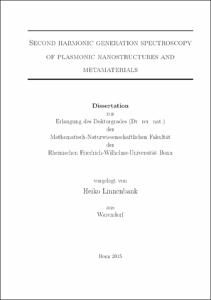Second harmonic generation spectroscopy of plasmonic nanostructures and metamaterials

Second harmonic generation spectroscopy of plasmonic nanostructures and metamaterials

| dc.contributor.advisor | Linden, Stefan | |
| dc.contributor.author | Linnenbank, Heiko | |
| dc.date.accessioned | 2020-04-21T07:53:05Z | |
| dc.date.available | 2020-04-21T07:53:05Z | |
| dc.date.issued | 20.08.2015 | |
| dc.identifier.uri | https://hdl.handle.net/20.500.11811/6506 | |
| dc.description.abstract | Plasmonic nanostructures and metamaterials composed of those are promising tools for the manipulation and generation of light. Their key feature is an engeneerable optical response, which is based on the possibility to tailor their localized plasmon modes. In this thesis second harmonic generation (SHG) from plasmonic nanostructures and metamaterials is investigated by means of SHG spectroscopy. For this purpose a frequency tunable femtosecond light source is developed. This light source is based on optical parametric generation and amplification with a double-pass geometry in a single macroscopic lithium niobate crystal. By this, femtosecond pulses generated by a 42 MHz repetition rate passively mode-locked Yb:KGW oscillator are converted into more than two watts of tunable near-infrared radiation between 1370 nm and at least 1650 nm. Beside its high average output power this device shows a high long term stability and allows to achieve pulse durations down to below 200 fs. With the help of this system the interplay between the local intensity enhancement, inherent to plasmonic nanostructures and the nonlinear optical response of dielectric matter is investigated. By combining the results of linear extinction measurements and SHG spectroscopy it is revealed that an increase of the SHG efficiency of plasmonic nanoantennas obtained by filling their feed gaps with a dielectric nanoparticle is independent of the nonlinear properties of the dielectric. Furthermore it is shown that the SHG efficiency of plasmonic nanoantennas is several orders of magnitude higher than that of nonlinear dielectric nanoparticles. By comparing a series of nanoantenna arrays, owning spectral distinct plasmonic resonances, it is shown, that the SHG efficiency of these structures is strongly dependent and resonantly enhanced by two-photon resonances, i.e., resonances for the generated second harmonic light. This result is qualitatively and in part also quantitatively explained in a metamaterial picture, connecting the results of linear extinction spectroscopy with those of SHG spectroscopy measurements via an anharmonic oscillator model. Furthermore noncentrosymmtric nanostructures resonant for the generated light are studied. This study indicates that the general symmetry selection rules for second harmonic generation can be also applied to plasmonic nanostructures. | en |
| dc.language.iso | eng | |
| dc.rights | In Copyright | |
| dc.rights.uri | http://rightsstatements.org/vocab/InC/1.0/ | |
| dc.subject | Plasmonic | |
| dc.subject | Metamaterialien | |
| dc.subject | Frequenzverdoppelung | |
| dc.subject | Optisch-Parametrische Erzeugung | |
| dc.subject | Metamaterials | |
| dc.subject | Second harmonic generation | |
| dc.subject | Optical parametric generation | |
| dc.subject.ddc | 530 Physik | |
| dc.title | Second harmonic generation spectroscopy of plasmonic nanostructures and metamaterials | |
| dc.type | Dissertation oder Habilitation | |
| dc.publisher.name | Universitäts- und Landesbibliothek Bonn | |
| dc.publisher.location | Bonn | |
| dc.rights.accessRights | openAccess | |
| dc.identifier.urn | https://nbn-resolving.org/urn:nbn:de:hbz:5n-40706 | |
| ulbbn.pubtype | Erstveröffentlichung | |
| ulbbnediss.affiliation.name | Rheinische Friedrich-Wilhelms-Universität Bonn | |
| ulbbnediss.affiliation.location | Bonn | |
| ulbbnediss.thesis.level | Dissertation | |
| ulbbnediss.dissID | 4070 | |
| ulbbnediss.date.accepted | 27.07.2015 | |
| ulbbnediss.institute | Mathematisch-Naturwissenschaftliche Fakultät : Fachgruppe Physik/Astronomie / Physikalisches Institut (PI) | |
| ulbbnediss.fakultaet | Mathematisch-Naturwissenschaftliche Fakultät | |
| dc.contributor.coReferee | Soergel, Elisabeth |
Files in this item
This item appears in the following Collection(s)
-
E-Dissertationen (4442)




